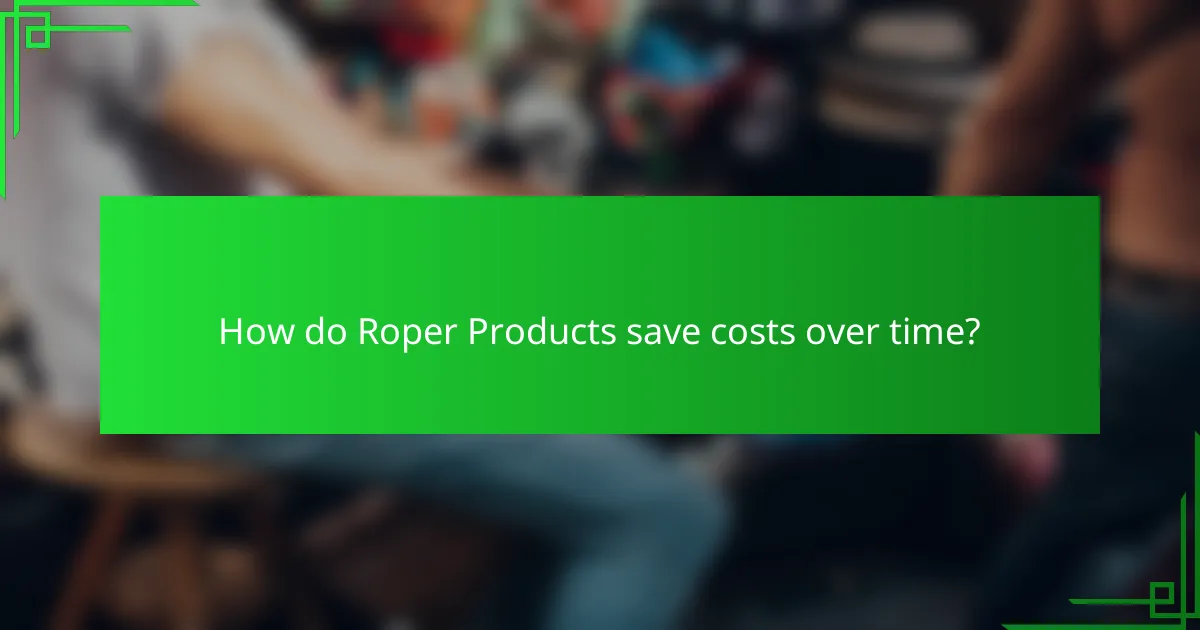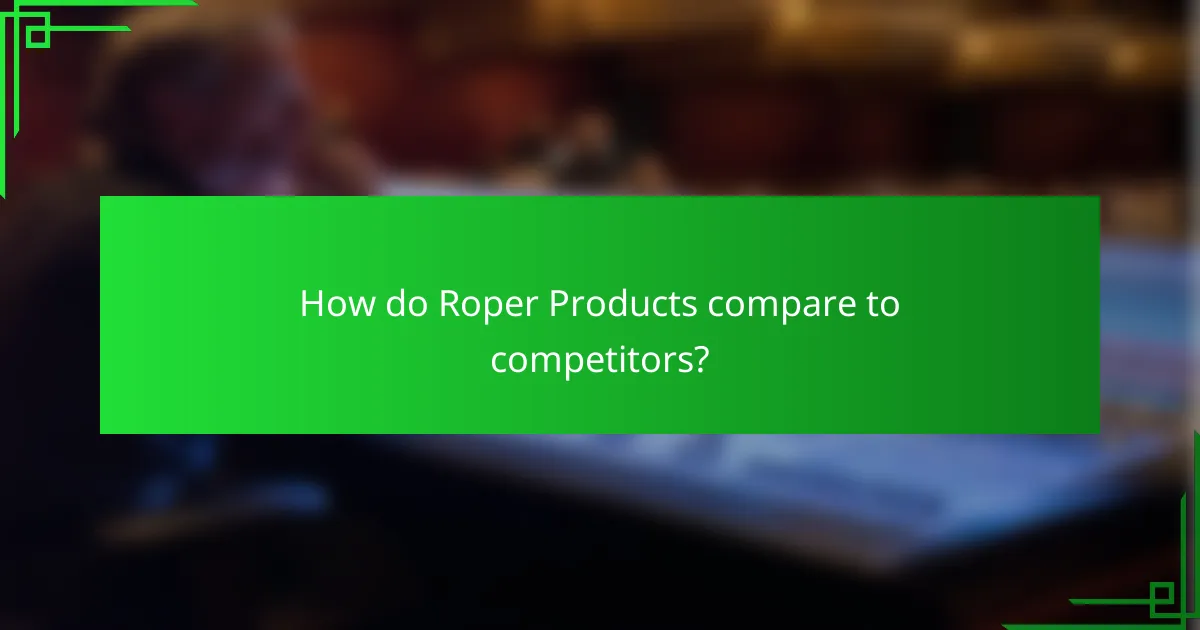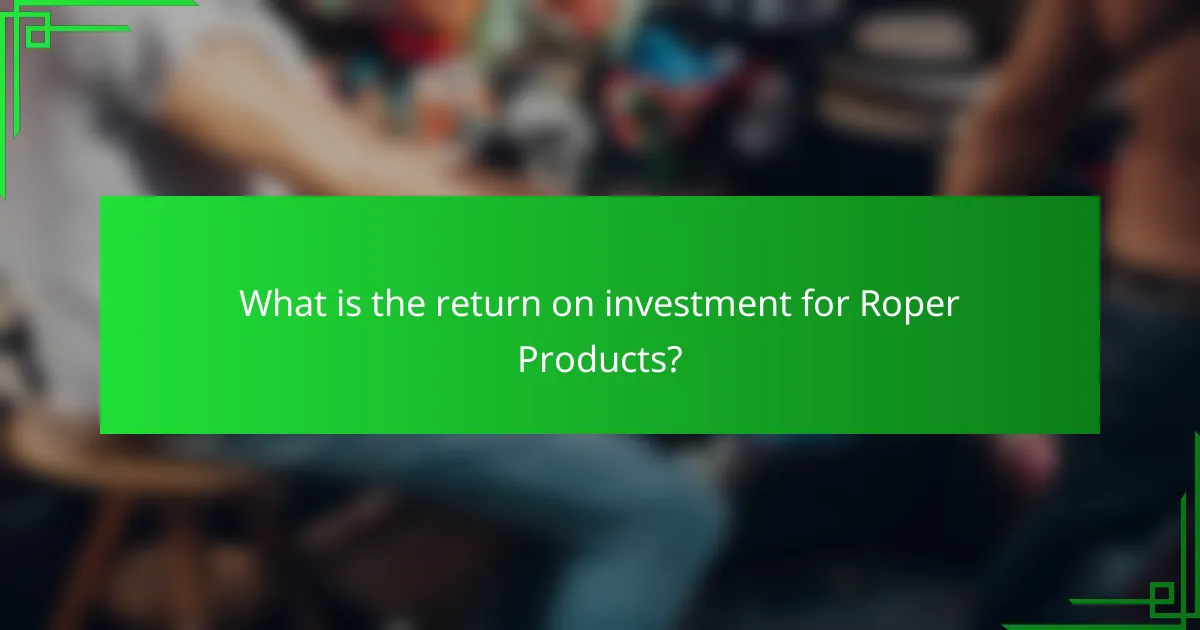Roper Products are designed to provide significant cost-effectiveness over time, thanks to their durability, energy efficiency, and maintenance-free features. By investing in these reliable solutions, consumers can enjoy reduced immediate expenses and substantial long-term savings, making Roper a smart choice in various applications.

How do Roper Products save costs over time?
Roper Products save costs over time primarily through their durability, energy efficiency, and maintenance-free features. These aspects not only reduce immediate expenses but also contribute to long-term savings for consumers.
Durability reduces replacement frequency
The robust construction of Roper Products means they are less likely to need replacement compared to cheaper alternatives. This durability can extend the lifespan of appliances and fixtures, often lasting several years longer than standard products.
By investing in Roper Products, consumers can avoid the frequent costs associated with replacements. For instance, a durable washing machine may last over a decade, while a less resilient model might need replacing every five years, leading to significant savings in the long run.
Energy efficiency lowers utility bills
Roper Products are designed with energy efficiency in mind, which can lead to lower utility bills. Appliances that meet or exceed energy standards consume less electricity, translating to savings on monthly energy costs.
For example, a Roper refrigerator might use up to 30% less energy than older models, resulting in savings of tens of dollars each year. Over time, these savings can add up, making the initial investment more economical.
Maintenance-free features minimize upkeep costs
Many Roper Products incorporate maintenance-free features that eliminate the need for regular servicing. This not only saves money but also time, as consumers do not have to schedule or pay for routine maintenance checks.
For instance, self-cleaning ovens and sealed systems in dishwashers reduce the frequency of repairs and upkeep. This can lead to hundreds of dollars saved over the lifespan of the product, making Roper Products a cost-effective choice for households.

What are the key features of Roper Products?
Roper Products are known for their durability, innovative technology, and cost-effectiveness over time. These features contribute to their reputation as reliable solutions in various applications.
High-quality materials ensure longevity
Roper Products are constructed using high-quality materials that significantly enhance their lifespan. For example, components made from corrosion-resistant metals or durable plastics can withstand harsh environments and frequent use.
Investing in Roper Products often means lower replacement costs over time. Users can expect these products to perform effectively for several years, reducing the need for frequent purchases.
Innovative technology enhances performance
Roper Products incorporate innovative technology that improves their overall performance and efficiency. Features such as advanced sensors and automated controls allow for precise operation, which can lead to better outcomes in various applications.
Additionally, the integration of smart technology can streamline processes, saving time and resources. This technological edge not only enhances user experience but also contributes to long-term cost savings by optimizing performance.

How do Roper Products compare to competitors?
Roper Products are generally considered cost-effective compared to competitors, particularly in terms of long-term reliability and maintenance costs. While upfront prices may be similar, Roper’s durability often leads to lower overall expenses over time.
Roper vs. Whirlpool: Cost-effectiveness analysis
When comparing Roper and Whirlpool, Roper typically offers lower initial prices, making it an attractive option for budget-conscious consumers. However, Whirlpool appliances often come with advanced features that may justify their higher price tags in terms of energy efficiency and performance.
In terms of long-term cost-effectiveness, Roper appliances tend to require less frequent repairs, which can lead to savings on maintenance. Consumers should consider their usage patterns and whether the additional features of Whirlpool appliances align with their needs.
Roper vs. GE: Feature comparison
Roper products are known for their straightforward design and functionality, focusing on essential features without unnecessary complexity. In contrast, GE appliances often include advanced technology and smart features that enhance user experience but may come with a higher price point.
While Roper may lack some of the high-tech options found in GE products, it compensates with reliability and ease of use. Buyers should weigh the importance of features against the potential for increased long-term costs when choosing between these brands.

What is the return on investment for Roper Products?
The return on investment (ROI) for Roper Products is generally favorable due to their durability and efficiency, leading to long-term savings. By investing in Roper Products, customers can expect reduced operational costs and enhanced property value over time.
Long-term savings on energy consumption
Roper Products are designed with energy efficiency in mind, which can lead to significant savings on utility bills. For instance, appliances that meet ENERGY STAR standards typically consume 10-50% less energy than non-certified models, translating to lower monthly expenses.
When evaluating potential savings, consider the initial cost versus the expected reduction in energy usage. Over several years, these savings can accumulate, often covering the initial investment and yielding a positive ROI.
Increased property value with quality appliances
Investing in high-quality Roper Products can enhance the overall value of your property. Homes equipped with modern, efficient appliances are often more attractive to buyers, potentially leading to higher sale prices.
In real estate markets, properties with updated appliances can see a value increase of 5-10% compared to similar homes without such features. This makes Roper Products not just a functional choice, but a strategic investment in your property’s future worth.

What factors influence the cost-effectiveness of Roper Products?
The cost-effectiveness of Roper Products is influenced by various factors, including initial purchase price, long-term savings, warranty coverage, and service agreements. Understanding these elements can help buyers make informed decisions that maximize value over time.
Initial purchase price versus long-term savings
The initial purchase price of Roper Products may be higher than some alternatives, but this can be offset by long-term savings. For instance, energy-efficient models often lead to reduced utility bills, which can save users hundreds of dollars annually.
When evaluating cost-effectiveness, consider the lifespan of the product. Roper Products are designed for durability, often lasting significantly longer than cheaper options. This longevity translates to fewer replacements and lower overall costs.
Warranty and service agreements impact value
Roper Products typically come with robust warranty options, which enhance their cost-effectiveness. A comprehensive warranty can cover repairs and replacements, reducing unexpected expenses and providing peace of mind.
Service agreements can further improve value by ensuring regular maintenance, which helps prevent costly breakdowns. When choosing a product, look for warranties that cover a substantial period, ideally several years, and consider the terms of service agreements to maximize your investment.

How do customer reviews reflect cost-effectiveness?
Customer reviews often highlight the cost-effectiveness of Roper products through their emphasis on long-term savings and performance. Many users report that the initial investment pays off over time due to durability and reduced operational costs.
Positive feedback on durability and savings
Many customers praise Roper products for their robust construction, which leads to fewer replacements and repairs. This durability translates into significant savings over the lifespan of the product, as users often find they spend less on maintenance compared to cheaper alternatives.
For instance, a washing machine that lasts over a decade can save hundreds of dollars compared to models that need replacing every few years. Customers frequently note that the initial higher price is justified by the longevity and reliability of Roper products.
Customer testimonials on energy efficiency
Roper products are often recognized for their energy efficiency, which contributes to lower utility bills. Many users report noticeable reductions in energy consumption, leading to savings that can offset the purchase price over time.
For example, energy-efficient appliances can reduce electricity costs by 20-30% compared to standard models. Customers appreciate the combination of performance and savings, reinforcing the overall cost-effectiveness of choosing Roper products.

What are the maintenance considerations for Roper Products?
Roper Products are designed with low maintenance needs, which contributes significantly to their cost-effectiveness over time. Understanding these maintenance considerations can help users maximize efficiency and minimize unexpected expenses.
Low maintenance requirements enhance savings
The low maintenance requirements of Roper Products mean that users can save on both time and costs. Regular upkeep typically involves simple tasks that can often be performed without specialized tools or training.
For instance, routine inspections and basic cleaning can keep the products functioning optimally. This straightforward approach can lead to reduced downtime and lower overall maintenance expenses, often translating to savings of several hundred dollars annually.
Easy-to-access parts for repairs
Roper Products are designed with accessibility in mind, making it easier to replace or repair parts when necessary. This design feature minimizes the need for professional service, allowing users to handle repairs themselves.
Common replacement parts are readily available and can often be sourced from local suppliers or online retailers. This ease of access not only reduces repair costs but also shortens the time needed to get products back in service, enhancing overall productivity.

How do Roper Products perform in different environments?
Roper Products are designed to perform reliably across various environments, including residential, commercial, and industrial settings. Their durability and adaptability make them suitable for diverse applications, ensuring consistent performance regardless of the conditions.
Residential Environments
In residential settings, Roper Products excel due to their user-friendly design and energy efficiency. These products often meet or exceed local building codes, providing homeowners with peace of mind. For example, Roper’s appliances typically consume less energy, which can lead to savings on utility bills over time.
Homeowners should consider factors like installation requirements and maintenance needs when selecting Roper Products. Regular maintenance can enhance longevity and efficiency, ensuring optimal performance throughout the product’s lifespan.
Commercial Environments
In commercial environments, Roper Products are valued for their robustness and reliability under heavy usage. These products often feature enhanced durability to withstand the rigors of daily operations in restaurants, offices, and retail spaces. Businesses can benefit from lower downtime and maintenance costs, contributing to overall cost-effectiveness.
When choosing Roper Products for commercial use, it’s essential to assess the specific demands of the environment. Factors such as load capacity and frequency of use should guide decisions to ensure the selected products can handle the expected workload.
Industrial Environments
Roper Products are engineered to perform in industrial environments where durability and performance are critical. These products often comply with industry standards, ensuring they can withstand extreme conditions such as high temperatures, moisture, and heavy impacts. This reliability translates to lower replacement costs and reduced operational disruptions.
When implementing Roper Products in industrial settings, companies should evaluate the specific environmental challenges they face. Understanding the operational context can help in selecting the right models that will deliver the best performance and longevity.
